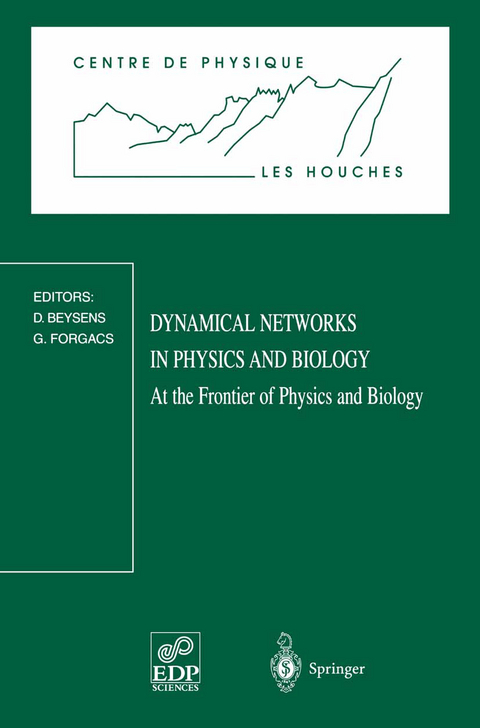
Dynamical Networks in Physics and Biology
Springer Berlin (Verlag)
978-3-540-65349-3 (ISBN)
Lecture 1 Cooperative Phenomena in Physical Networks.- Networks of Biopolymers.- Lecture 2 Complex Networks in Cell Biology.- Lecture 3 The Keratocyte Cytoskeleton: A Dynamic Structural Network.- Lecture 4 Adhesion Mediated Signaling: The Role of Junctional Plaque Proteins in the Regulation of Tumorigenesis.- Lecture 5 Of Proteins, Redox States and Living Things.- Lecture 6 Tensegrity and the Emergence of a Cellular Biophysics.- Lecture 7 The Leukocyte Actin Cytoskeleton.- Lecture 8 Branched Polymers and Gels.- Lecture 9 Statistical Mechanisms of Semiflexible Polymers: Theory and Experiment.- Lecture 10 Scale Effects, Anisotropy and Non-Linearity of Tensegrity Structures: Applications to Cell Mechanical Behavior.- Cellular and Extracellular Networks.- Lecture 11 Networks of Extracellular Matrix and Adhesion Proteins.- Lecture 12 Networks of Extracellular Fibers and the Generation of Morphogenetic Forces.- Lecture 13 First Steps Towards a Comprehensive Model of Tissues, or: A Physicist Looks at Development.- Lecture 14 Networks of Droplets Induced by Coalescence: Application to Cell Sorting.- Lecture 15 A Monte-Carlo Approach to Growing Solid Non-Vascular Tumors.- Genetic, Immune, Molecular and Metabolic Networks.- Lecture 16 Intracellular Communication via Protein Kinase Networks.- Lecture 17 Molecular Networks that Regulate Development.- Lecture 18 H-Bond Networks in Stability and Function of Biological Macromolecules.- Lecture 19 A Network of Cell Interactions Mediated by Frizzled is Essential for Gastrulation and Anteroposterior Axis Determination in Xenopus Embryos.- Lecture 20 Fluid Lipid-Bilayer Membranes: Some Basic Physical Mechanisms for Lateral Self-Organization.- Lecture 21 Logical Analysis of Timing-Dependent Signaling Properties in the Immune System.- Lecture 22 A Water Channel Network in Cell Membranes of the Filter Chamber of Homopteran Insects.- Lecture 23 Creative Genomic Webs.- Neuronal Networks.- Lecture 24 Hebbian Learning of Temporal Correlations: Sound Localization in the Barn Owl Auditory System.- Application of Physical Models and Phenomena to Biological Systems.- Lecture 25 Structures of Supercoiled DNA and their Biological Implications.
| Erscheint lt. Verlag | 17.11.1998 |
|---|---|
| Reihe/Serie | Centre de Physique des Houches |
| Zusatzinfo | XVI, 315 p. 134 illus. |
| Verlagsort | Berlin |
| Sprache | englisch |
| Maße | 155 x 235 mm |
| Gewicht | 540 g |
| Themenwelt | Informatik ► Theorie / Studium ► Künstliche Intelligenz / Robotik |
| Naturwissenschaften ► Physik / Astronomie ► Angewandte Physik | |
| Schlagworte | Biology • Biophysics • Cell • Cell Biology • cell membrane • Cytoskeleton • DNA • immune system • Insects • leukocyte • Membrane • Molecule • Regulation • tissue • Tumors |
| ISBN-10 | 3-540-65349-X / 354065349X |
| ISBN-13 | 978-3-540-65349-3 / 9783540653493 |
| Zustand | Neuware |
| Haben Sie eine Frage zum Produkt? |
aus dem Bereich


